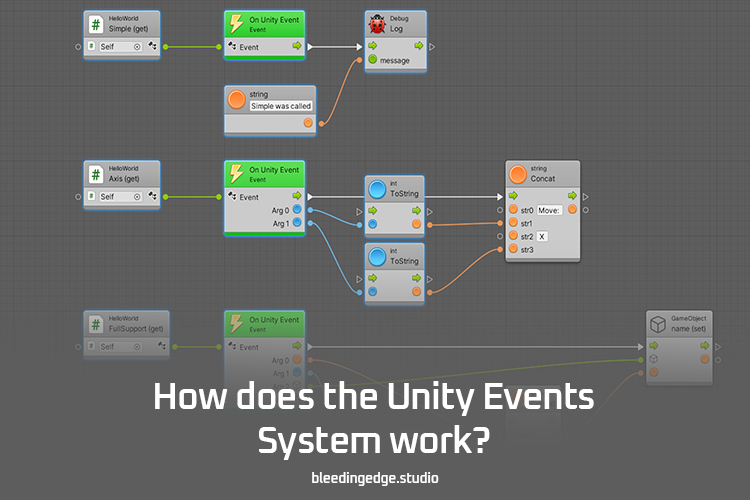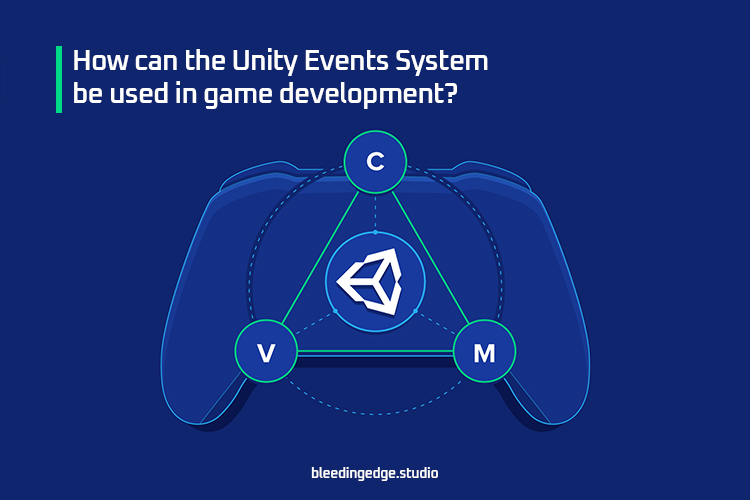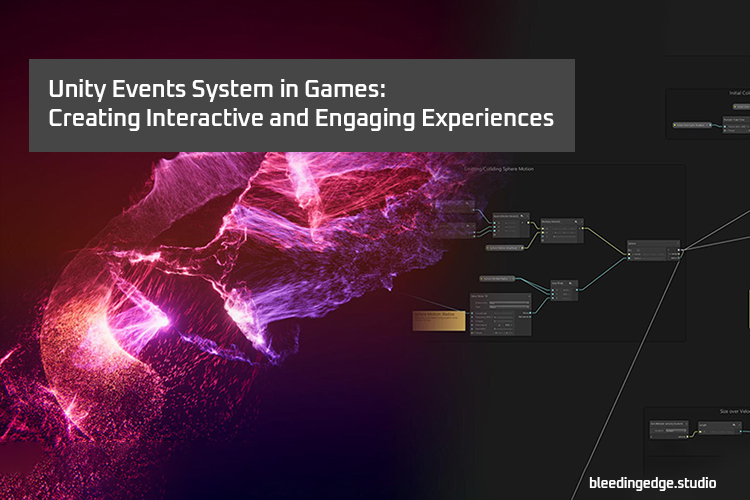Unity Events System in Games: Creating Interactive and Engaging Experiences
The Unity Events System is an essential tool for game developers looking to create interactive and engaging player experiences. With this system, developers can create events and triggers that allow players to interact with the game world meaningfully. In this blog post, we’ll explore the Unity Events System, how it works, and how it can be used to create more immersive and engaging games.
What is the Unity Events System?
The Unity Events System is a component-based system that allows developers to create events and triggers that can be used to trigger actions in their games. These triggers can be linked to specific actions, such as playing a sound effect or animating a character. Various inputs, such as player input or environmental triggers, can activate them.
How does the Unity Events System work?

The Unity Events System allows developers to define events and triggers linked to specific actions within the game. These events and triggers can be set up using the Unity Editor. They can be linked to various inputs, such as player input or environmental triggers for Unity Event Systems.
For example, a developer might set up an event triggered when a player picks up a certain item in the game world. This event could be linked to a trigger that plays a sound effect, animates a character, or opens a door.
Once the events and triggers have been defined, the developer can use them to create a more interactive and engaging player experience. Players can trigger these events by interacting with the game world and seeing their actions’ effects in real-time.
How can the Unity Events System be used in game development?

The Unity Events System can be used in various ways to create more interactive and engaging games. Here are some examples:
Player Interactions: The Unity Events System can be used to create more meaningful player interactions within the game world. By linking events and triggers to player actions, developers can create a more immersive experience that lets players feel like they are truly a part of the game world for Unity Event Systems.
For example, a developer might create an event triggered when a player interacts with an NPC in the game world. This event could be linked to a trigger that plays a sound effect, animates the NPC, or rewards the player.
Environmental Triggers: The Unity Events System can create more dynamic and interactive environments. By linking events and triggers to environmental triggers, such as weather changes or time of day, developers can design a more immersive and engaging experience for players.
For example, a developer might create an event triggered when the sun sets in the game world. This event could be linked to a trigger that changes the lighting in the game world or triggers a new set of enemies to appear.
Game Progression: The Unity Events System can create more meaningful game progression. By linking events and triggers to specific game milestones, developers can create a sense of accomplishment and progress for players.
For example, a developer might trigger an event when a player completes a game level. This event could be linked to a trigger that rewards the player, such as a new weapon or ability.
How Does the Unity Events System Work?
At its core, the Unity Events System is a set of tools and components allowing developers to define game events and triggers. These events can be linked to specific actions, such as playing a sound effect, spawning an enemy, or triggering an animation.
To set up an event in Unity, developers can use the Events Manager, a component that can be tied to any game object in the scene. This component allows developers to create a new event, specify its parameters, and link it to a trigger for Unity Event Systems.
Triggers, conversely, are components that can be added to any game object and are used to activate events. There are several types of triggers in Unity, including:
- Input Triggers: These triggers are activated by player input, such as pressing a button or moving the mouse.
Collision Triggers: These triggers are activated when a game object collides with another game object. - Trigger Zones: These triggers are areas in the game world activated when a player or game object enters or exits them.
Once an event and trigger have been defined, developers can use them to create more interactive and engaging game experiences. For example, a developer might set up an event triggered when a player interacts with an NPC in the game world. This event could be linked to a trigger that plays a sound effect, animates the NPC, or rewards the player.
How the Unity Events System can be used in game development?
There are countless ways that the Unity Events System can be used in game development, but here are a few examples of Unity Event Systems:
Interactive Environments: One of the primary benefits of the Unity Events System is that it allows developers to create more interactive and dynamic game environments. By linking events and triggers to environmental factors such as weather, time of day, or location, developers can design a more immersive and engaging experience for players.
For example, a developer might create an event triggered when a player enters a certain area of the game world. This event could be linked to a trigger that spawns a new enemy, changes the lighting, or triggers a new sound effect.
Player Feedback: Another key benefit of the Unity Events System is that it allows developers to provide more meaningful feedback to players. By linking events and triggers to specific player actions, such as picking up an item or completing a task, developers can create a sense of accomplishment and progress for players.
For example, a developer might trigger an event when a player completes a game level. This event could be linked to a trigger that rewards the player, such as a new weapon or ability.
Multiplayer Interactions: The Unity Events System can also be used to create more engaging multiplayer experiences. By linking events and triggers to player interactions, such as kills, assists, or team objectives, developers can create a more dynamic and engaging experience for players.
For example, a developer might create an event triggered when a player kills an enemy in a multiplayer match. This event could be linked to a trigger that gives the player a score bonus or unlocks a new weapon.
Cutscenes and Animations: Finally, the Unity Events System can be used to create more engaging cutscenes and animations. By linking events and triggers to specific animation sequences, developers can create more immersive and dynamic cutscenes that respond to player actions for Unity Event Systems.
For example, A developer can trigger an event when a player reaches a certain point in the game world. This event could be linked to a trigger that plays a cutscene or animation sequence that responds to the player’s actions.
Let’s say the player has been traveling through a dark, creepy forest for the past few levels of the game. As they approach a certain point in the forest, the Unity Events System is triggered, which causes a cutscene to play.
In this cutscene, the player encounters a terrifying creature to defeat to progress to the next level. The cutscene could be scripted to respond to the player’s actions, such as showing different camera angles and animations depending on which attacks the player uses to defeat the creature.
Alternatively, the Unity Events System could trigger an animation sequence that responds to the player’s movements. For example, the player might need to climb up a tall tower to reach the next level of the game. As they climb, the Unity Events System could be triggered to play an animation sequence that shows the player’s progress up the tower.
This sequence could be programmed to respond to the player’s movements and actions, such as showing different animations and camera angles depending on how fast the player climbs or which obstacles they encounter on their way up.
In either case, the Unity Events System is used to make a more immersive and engaging experience for the player. By linking events and triggers to specific actions and environmental factors, developers can create more dynamic and interactive game worlds that respond to the player’s actions in real time.

Quests and Objectives: The Unity Events System can be used to create more engaging quest and objective systems. Developers can create a more dynamic and engaging player experience by linking events and triggers to specific quest objectives.
For example, a developer might trigger an event when a player picks up a quest item. This event could be linked to a trigger that updates the quest log or displays a new objective for the player.
User Interface: The Unity Events System can create more engaging user interfaces. Developers can create more dynamic and interactive menus and HUDs by linking events and triggers to specific UI elements.
For example, a developer might trigger an event when a player hovers over a UI button. This event could be linked to a trigger that plays a sound effect or displays additional information about the button.
Sound Effects and Music: Finally, the Unity Events System can be used to create more immersive sound effects and music. By linking events and triggers to specific audio cues, developers can create a more dynamic and responsive audio experience for players.
For example, a developer might create an event triggered when a player enters a new area of the game world. This event could be linked to a trigger that changes the background music or adds new sound effects to the environment for Unity Event Systems.
Conclusion
The Unity Events System is a powerful tool that allows developers to create more dynamic and engaging game experiences. Developers can create more immersive and interactive game worlds by linking events and triggers to specific actions and environmental factors.
From interactive environments and player feedback to multiplayer interactions and cutscenes, there are countless ways that the Unity Events System can be used in game development. By mastering this tool, developers can create more engaging and enjoyable games for players and, ultimately, be more successful in the marketplace.

